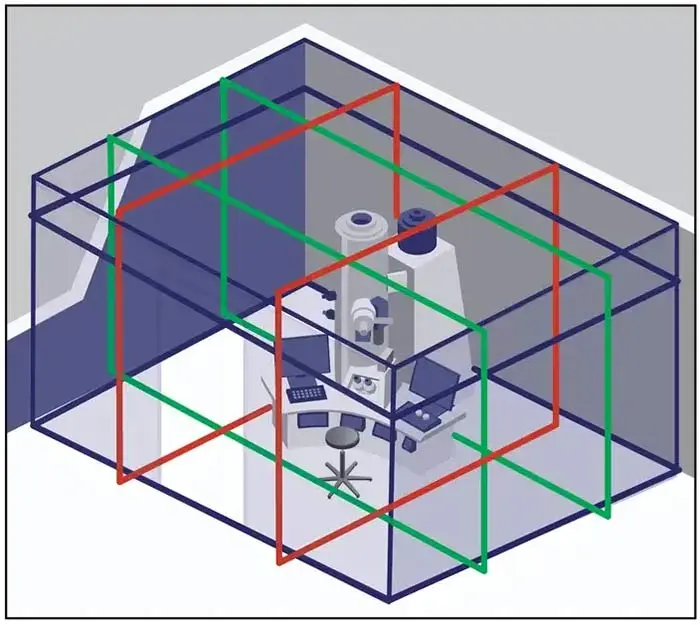Double Loop Room Size Field Cancelling Cables
- Home
- /
- Products
- /
- Magnetic Field Cancellation
- /
- Double Loop Room Size Field Cancelling Cables
Overview
These cables are designed for use with SC22 and SC24 magnetic field cancelling systems in large TEM installations. However, they may be used on any type of microscope and are useful on SEMs when the magnetic fields are very large. They are supplied in sets of 3, one each for the X, Y and Z axes of the cancelling system.
Each cable has two main loops with multiple turns that plug together with a pair of 9-pin D-type connectors. A separate tail cable consists of two-core cables that run from each loop back to a 9-pin D-type connector that plugs into the control unit. The cables are screened to protect the outputs from RF pickup.
In the drawing, the lower parts of the X & Y cables are shown buried below the floor. This is practical for new-build labs. Parts of the bottom Z cable also need to be buried at door openings.
Burying the X & Y cables below the floor is recommended for a TEM with a Gatan Imaging Filter (GIF) for good cancelling at GIF height.
For existing microscope installations where burying cables is not an option, the bottom sections of the cables can be at floor level and covered with suitable cable protectors. The X and Y cancelling performance at GIF height will be compromised.
- Double loop room cables for TEM and large field installations
- Supplied in sets of 3 for the X, Y and Z axes
- Compatible with Spicer Consulting SC22 and SC24 Magnetic Field Cancelling Systems
- Multi-core screened cables with D-type connectors
- Two Main loop cables and separate dual “tail” cable for ease of installation
- Field Ok indicator (green)

Installation
Guidelines for cable layouts are included in the SC22 and SC24 user manuals. Cables may be routed on walls in plastic wireways or laid above suspended ceilings or below raised floors. Cables may be routed in pipes embedded into a concrete floor or run across the floor in suitable protectors.
These cables carry low voltages (±20 V max), so it is not necessary to specify electrical grade conduit. Cables may be routed in plastic or steel conduits. However, it is important that the conduit does not make an electrically conducting loop, because this would act as a transformer with a shorted turn, reducing the dynamic range (the maximum field that can be cancelled).
The required conduit diameters are shown in the specifications. The larger sizes make for easier installation. If smaller sizes must be used, the connector hoods or even the entire connector can be removed and replaced on site.
The cables are labelled with color-coded directional arrows. This helps to ensure that they are installed so that both loops go around in the same direction.
If there is excess cable in the main loop, it should not be coiled, because that would make a magnetic field. It should be doubled back on itself and bundled tightly so that the field cancels out. The tails do not create any significant magnetic field.
The drawing shows a typical double loop installation. The dimensions of the dual loop cables have been optimized to make the cable fields uniform over the length of the microscope column for this size room. Every microscope room is different, and the optimum cable spacings depend on the room size and height. There are often doors, pillars, beams and other features that make the room shape more complicated. VEC has many years’ experience in designing custom cable layouts. We build custom cables for each double loop room installation.
SC22 Features
- Weight:7 kg (set of 3) (typ)
- Loop Length: Custom made for each room
- Tail Length: 7 m (X, Y, Z)
- No. Loops: 2
- No. Cores 6
- Type of cores7/0.2
- Outside diameter: 5.9 mm/li>
- Loop connector: 9-way D-type
- Tail connector:9-way D-type
- Min conduit diameter:55 mm (Hood on)
- 40 mm (Hood off)
- 20 mm (Connector off)
- Compatible with: SC22 field cancelling system
- SC24 field cancelling system
- Not designed for use separately